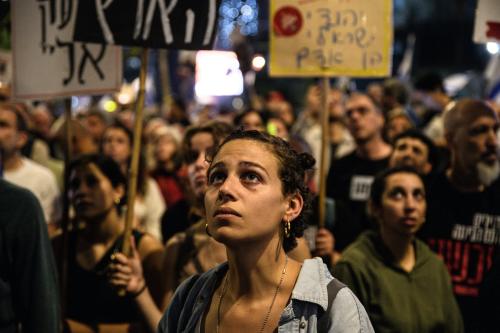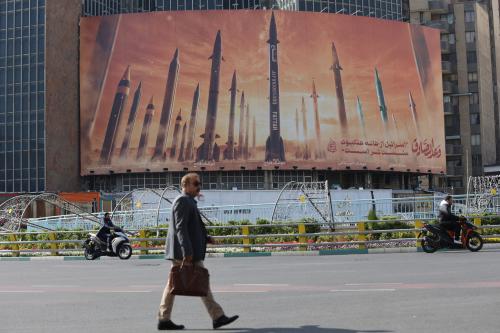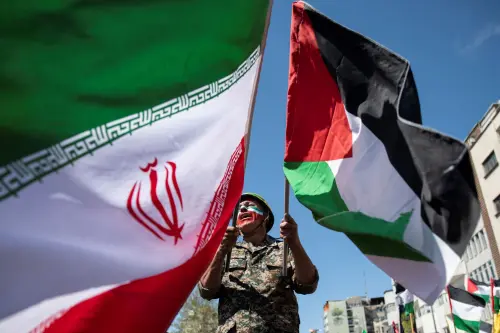Recently, Syrian Defense Minister Hassan Turkmani and his Iranian counterpart, General Mostafa Mohammad Najjar, signed a mutual defense pact and formalized the establishment of a joint Iranian-Syrian Supreme Defense Commission to institutionalize long-term military cooperation. Although there were no details about the pact, anxious Arab and Israeli defense experts were quick to exaggerate its significance. This played right into Syrian and Iranian hands, for it failed to reflect how much Tehran and Damascus, both under increasing international pressure, were trying to revive the glory days of their alliance during the 1980s.
Media reports jumped to two conclusions about the Iranian-Syrian agreement: that Iran has promised to supply Syria with shoulder-launched anti-aircraft missiles, Shehab-3 missiles with a range of 1,350 kilometers, Russian-made T-72 tanks, and short-range SCUD missiles; and that Iran has agreed to finance future Syrian military deals with Russia, China, and Ukraine.
Such reports not only inflated the impact of the Iranian-Syrian pact; analysts also misinterpreted its meaning. Although Iran may supply Syria with low-level weaponry, such as shoulder-launched anti-aircraft missiles, it is unlikely to equip Syrian forces with advanced military hardware. Iran possesses too few Shehab-3 missiles (reportedly between 25 and 100) and T-72 tanks (a little less than 500) to spare. Furthermore, the Islamic Republic knows that supplying Syria with strategic and ballistic missiles would be highly provocative to Israel, which is not in Iran’s interest at this time.
The pact could have raised eyebrows in the American and Israeli governments, but for three reasons it did not. First, Turkmani dismissed the possibility of hosting an Iranian military base on Syrian soil. Second, neither of the two countries pledged to protect the other in the event of an attack. Third, even assuming a NATO-style Iranian-Syrian defense pact were signed, the strategic alliance between the United States and Israel would dwarf it. Washington has made it a fixed policy that Israel remain the most powerful military actor in the region. Though Israel may lack strategic depth, with American military and economic assistance it possesses unmatched aerial power, the most advanced ground forces, and a unique nuclear deterrent capability.
The Iranian-Syrian meeting was mostly intended to send a political message to Washington that Tehran and Damascus are anything but isolated, and that their alliance exceeds the sum of its parts. The two countries hope to create an impression that they have additional resources at their disposal to deter outside, particularly American, intimidation.
For Syria, the pact with Iran is important as its regime faces international suspicion for its alleged role in the killing of the former Lebanese prime minister, Rafik Hariri. As for Iran, the agreement with the Syrians is destined to increase its leverage in current negotiations over its nuclear program. Iran has put its ties with Syria on the table with the intention of reminding Washington that, if the negotiations fail, Iran will still possess an alternative strategy – that of resorting to challenging, with Syrian help, American and Israeli regional ambitions.
But how effective is the alliance today between Iran and Syria, and how effective was it at its height, during the 1980s?
Soon after the Iranian revolution, Syria and Iran became natural partners, sharing strategic calculations, common enemies, and a desire to exert influence over the balance of power in the Middle East. Both coordinated policy in Lebanon and together supported anti-Israeli rejectionist movements – which they still do. During the Iran-Iraq war, the Iranian war effort gained considerably from the alliance. Syria’s shutdown of the trans-Syria pipeline deprived Iraq of half of its oil export capacity and $17 million per day in revenues, thereby damaging its ability to finance its war economy. Syria’s deployment of troops along Iraq’s border forced Saddam Hussein to reposition troops from the Iranian front. In return, Iran subsidized Syria with its oil revenues (though in lesser amounts than the Saudis), thereby boosting a vulnerable Syrian economy.
Today, however, some key Syrian and Iranian interests differ substantially, even if the two states see eye to eye on other issues. Take Iraq, where Iran stands by its Iraqi Shiite allies, such as the Supreme Council for the Islamic Revolution in Iraq (SCIRI), Al-Daawa, and the Mehdi Army. A few months ago, SCIRI leader Abdul Aziz al-Hakim called for a Shiite state in south and central Iraq, in a federal framework. This caused alarm bells to ring in Damascus. Syria fears any partition of Iraq, whether along sectarian or ethnic lines, because of the threat this might pose to its own sectarian and ethnically diverse social structure.
So, while the Iranian-Syrian alliance remains one of convenience, the fault lines are not insignificant. That’s why the latest round of pact signing by Turkmani and Najjar should be seen as reviving an association that is only a shadow of its former self.



Commentary
Op-edSyria and Iran Revive an Old Ghost with Defense Pact
July 4, 2006